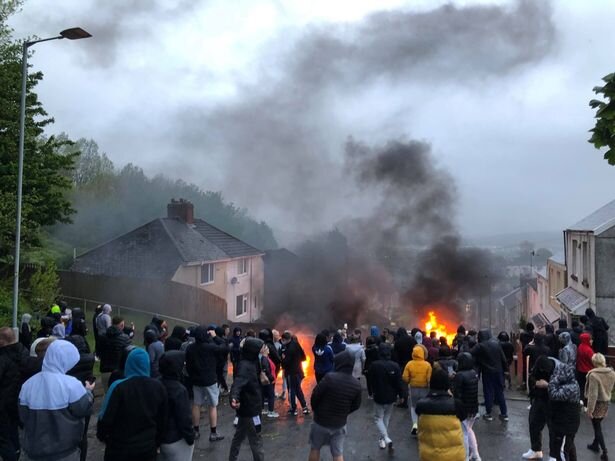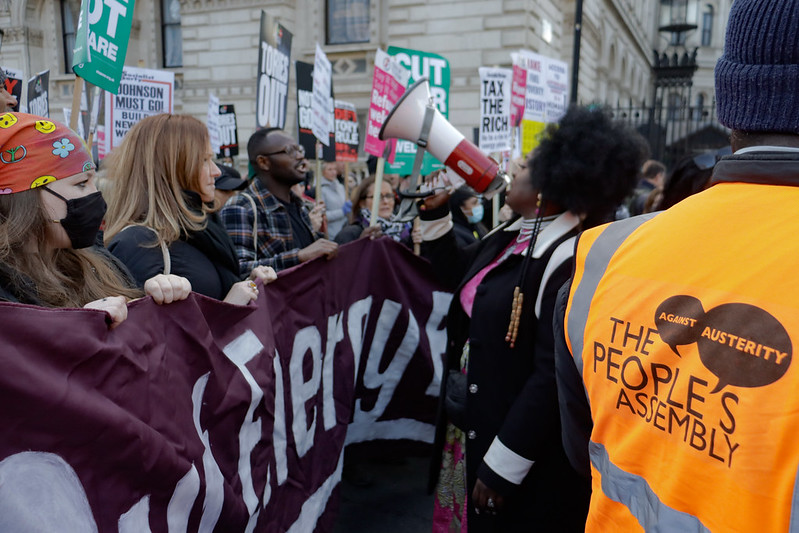
The Mayhill Rioters Knew Their Future Was Bleak, Is It Any Wonder They Kicked Off? | @phased_bemused
Young people in Mayhill watch burning cars. Photo, no credit.
“THE PRIMARY REASON WHY SOMEONE WOULD ENGAGE IN THE TYPE OF SPECTACULAR, FILMED SOCIAL DISORDER THAT WE SAW IN MAYHILL IS BECAUSE THEY, PERSONALLY AND COLLECTIVELY, BELIEVE THEY HAVE A DRASTICALLY CONSTRAINED FUTURE.”
Any event like the social disorder seen in Mayhill on Thursday last week following a memorial balloon release for Ethan Powell who died suddenly aged 19, is first experienced as a set of contextless, widely shared videos that spread almost instantaneously out from the scene of the event.
This sparks a flurry of attempts to analyse the events that we can all see – in this particular case, whether or not the videos show a dog that’s been set on fire, whether the police have intervened early enough, whether any meaning at all can be drawn from the event.
These are then followed by a wave of condemnations from public and private figures followed by promises to do something, whether in the form of increased social spending or more punitive measures directed at the people involved – usually, some promise of both. In order to understand what happened, none of these reflex reactions are sufficient and we must consider the broader context in which this breakdown occurred.
Firstly, the scenes in Mayhill are part of a set of unconnected but similar events that took place in and around the past year and more of coronavirus lockdowns punctuated by nervous attempts to lift coronavirus restrictions. A clear thread linking these – from illegal raves in Neath-Port Talbot and Manchester, to the clearly political actions undertaken in support of the Black Lives Matter movement and Palestinian liberation – has been the disproportionate involvement of young people, who’ve had many of the usual rites of passage of youth and early adulthood completely disrupted.
In absence of the normal, more diffuse opportunities to socialise and engage in risk-taking behaviour, it’s easy to imagine how this energy and human desire to congregate can only find expression in spaces that are, by the temporary fact of strength in numbers, effectively outside of the rule of coronavirus restrictions.
This goes some way to explaining why this may have happened now, but does not explain why it happened in Mayhill. For this we have to look deeper into the social & economic issues facing those people who took part in the riot.
By coincidence, last Thursday also saw the publication of a report which found that Wales has the worst child poverty rate out of all of the constituent parts of the United Kingdom. 31% of Wales’ children were found to be living in poverty, despite nearly 25 years of a government that has claimed to have poverty reduction and the rights of children and young people as core priorities.
Swansea, as a city, was the first testing place of the idea of an enterprise park in 1981, when a zone Llansamlet was designated to have lax building regulations in an attempt to draw inward investment from companies in order to substitute for the simultaneously planned continuation of deindustrialisation through the 1980s.
What this has meant, in practice, is the growth of Swansea as a hub of low-wage service economy work as employers are able to house employees cheaply and as technological developments have meant that customer service can be located relatively freely. Swansea’s median income is therefore lower than that of Cardiff, and neighbouring Carmarthenshire and Neath-Port Talbot.
Mayhill and Townhill are the poorest areas of Swansea, and as such, Mayhill and Townhill have a particular role in the psychogeography of people from Swansea and the surrounding areas as one of “the rough areas”, standing as bywords for poverty and joblessness, anti-social behaviour and crime.
There’s a subset of witless amateur comedy videos and songs, now easily shared and archived on social media, of people doing their best attempts at the local accent and parodying the supposed affect and behaviour of its residents.
Despite this, statistics show a majority of the people in Mayhill and Townhill are workers and/or carers, and the average net annual household income is £20,000. However, the next council ward over in Cockett, minutes of walking away, the average household income is £25,400. Less than ten minutes drive away in Sketty, the average semi-detached house will cost you just over £200,000, whereas in Townhill, it’ll cost just over £100,000.
These kind of disparities, far from being the product of the residents’ poor habits are the product of a society that sorts people into the those who control the economy – deciding who works where doing what and when – and on the other side, the people who have to work and the those who don’t or can’t work, and who’s unemployment and poverty then act as an example of what will happen to you if you don’t work.
In the post-WWII boom of the 1950s, unemployment in the United Kingdom reached its historic low of just above 1%, staying around these levels until the mid-1970s, since which point it’s almost never gone below 4%. For residents of Townhill and Mayhill, the figure of long-term unemployed, and those who’ve never worked, is around 13%.
These people kept out of work, in a society where there’s socially valuable work that needs to be done, are kept out of work to make sure that there’s always someone worse off than the poorest worker and who can, if the employed workers ask for more wages or makes trouble, be hired at a lower cost.
While local, regional and structural inequality provide the conditions in which resentment and contempt of authority can grow, the primary reason why someone would engage in the type of spectacular, filmed social disorder that we saw in Mayhill and that was seen on a much greater scale during the English riots of 2011, is because they, personally and collectively, believe they have a drastically constrained future.
Studies of the health attitudes of young people have previously found that they often drastically underestimate their future lifespan, and when this is coupled with shocks like, in this case – the early death of a contemporary, being told from birth that your area is the poor area of a poor city in a poor country, the immanent coronavirus-related economic slump – what future would you think you were risking if you bowled a car down the road on camera?
At the same time, a riot can offer those involved to offer a kind of instant liberation from, and resistance to, a system that deliberately keeps them poor and alienated.
Until Welsh society is able to provide a better answer to poverty and joblessness, scenes like those in Mayhill last week will continue to happen. We should resist the attempts by the state to criminalise these young people and reject the media and political clamour for a police crackdown in the area.
The state and the system it upholds are the real cause of ongoing social violence, not the young people of Mayhill.
@Phased_Bemused is a socialist from Swansea and co-hosts the Desolation Radio podcast


Keir Starmer Is Failing To Defend Our Human Rights | Elspeth Webb